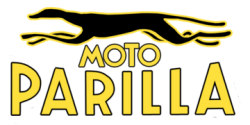


|
|
|
|
1957 Grand Sport (MSDS) |
1958-60 GS |
Cosmopolitan Motors started selling the GS in America in 1957. To help out with sales, the factory sent Giuseppi Rottigni to race the bikes on N. American tracks. Rottigni won many races and created interest for the Parilla racer. The GS is not a works bike, but a production factory race bike. It came equipped to ride on the street and on the track. All a new owner had to do was to remove any parts deemed unnecessary and go racing almost immediately - an instant race bike right out of the box. A 200cc upgrade was offered from 1959 to 1961. The factory and Cosmo sold many go-fast parts to GS owners, but it was up to the racers themselves to come up with the correct combination of parts & know-how to win on the track. This might explain why many GS bikes found today have all sorts of parts missing and owner modified design changes.
This is Rod Guy's GS racer that he used on the track in the 60's. The bike has many of the go-fast modifications found on the most serious Parilla track bikes.
Frames: To see the GS's frame compared to other high-cam frames, then click on to the frames page.
High-cam motor: To see some examples of various high-cam motors, then click onto the motors page.
Stats: CC: 175 / Compression: 1:8.4 / Output: 22HP @ 7900 RPM / Carburetion: Dell'Orto SS1 22.5 / Gas Tank: 2 1/4 Gallon / Gas Mileage: 77 MPG / Weight: 220 lbs. / Max Speed: 90-110 MPH
Prices and colors:
Very early GS bikes imported by Cosmo had black frame/fenders/toolboxes and a black & off-white/cream tank. Later imported GS's came with a silver and black tank which eventually became the Grand Sport's signature look. The first 175cc GS bikes were sold for $675 (1958) then dropped to $629 (1960) and a final price of $589 in 1961. The 200cc GS started out as $669 in 1960 and $649 in 1961.
Today's GS outlook: [1]
Finding a 1950's GS is difficult, but not impossible. Many bikes were stripped down for racing and the leftover parts went missing over the years. Word has it (unconfirmed) that Cosmo imported about 200 GS bikes in the late 50's. The frame and the 501-xxx serial number are two ways to tell that it's a GS. Matching numbers are not that big of a deal for a GS as long as the frame/motor use the same 501-xxx number series. Many restorations have the GS as a stripped down racer, but it would be worth more if it included it's original street trim. Prices for the GS are the highest among Parilla production bikes. Even an incomplete project will attract quite a bit of money.
N.B. 1. Today refers to c.2007.